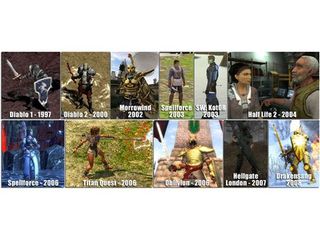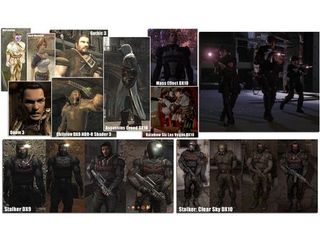Reality Check: 3D Graphics Take On Hollywood
Evolution Of Characters
The following images show the development of the characters with which you share your screen life. Let’s kick off in 1997; Diablo counts as something of a milestone because it was here that the character changed his or her appearance based on armor and weapons used. In terms of 3D graphics, Morrowind makes a large step forward also. The naked character still looks cheap, but when he or she pulls on the complex and multi-part armor, the level of detail changes dramatically. There are shoes, pants, shirts, cloaks, coats, bracers, leg armor, chest plates, shoulder pieces, helmets, weapons, and shields.
The level of detail of real-time games or action adventures can’t quite keep up. In 2004, Half Life 2 set new standards for facial expressions and the animation of characters. At this point, Nvidia’s shader campaign started to take hold with realistic skin tones and individual facial characteristics. In 2006, strategy games and action role plays were so detailed that, even close up, you couldn’t tell the difference between these and real 3D games.

As the follow-up to Morrowind, Oblivion also sets new milestones when it comes to graphics. For the first time, modern HDR rendering (Shader Model 3) is used, and armor and swords really start to shine. The complexity of the faces of the characters is very impressive; the many slide regulators enable the form and color of the eyes, lips, chin. mouth, nose and head to be influenced, resulting in an individual appearance for the figure. This wide range of options has no effect on the game. In Oblivion, you only act as a single player and the computer controlled players (NPCs) are not interested in the appearance of the figure.
Newer games like Hellgate London would profit from this complexity, as the characters also meet on the Internet and a more individual appearance would be necessary. The differences are limited to body size, hair, and skin color and the various pieces of equipment used by the characters to stand out from the crowd. If you look at the developments made between Oblivion and Drakensang, you can see the current standstill situation. The environment effects are improving, but the character details remain the same.
The following images show additional characters and the differences caused by the lighting used. Doom 3 does a lot with light and shadows which makes the graphics look more detailed. Gothic 3 and Oblivion both came onto the market in 2006. But while Gothic 3 continued to use the older bloom dazzle and shine effects, Oblivion used the new HDR rendering, which lights shiny spots and lighter colored surfaces in a softer and more colorful way. The leap to DirectX 10 can be seen in both Assassin’s Creed and Mass Effect. The improved HDR rendering (Shader 4) makes the graphics appear more realistic.

Stay on the Cutting Edge
Join the experts who read Tom's Hardware for the inside track on enthusiast PC tech news — and have for over 25 years. We'll send breaking news and in-depth reviews of CPUs, GPUs, AI, maker hardware and more straight to your inbox.
-
jimmysmitty Of course it can always get better. it just depends on how much of the power available to them the game designers want to use. For PC its harder though since they want the most sales and want to go from low to high end.Reply
Introducing MT in games would boost FPS allowing more and better eye candy.
A good example is L4D from VALVe. Source is a 4 year old engine but some of the graphics in that game are close to Crysis which is amazing to be honest since Crysis was made with a much newer engine.
It is also rumored to include MT capabilities. Will have to see.
Once game designers stop worrying as much they will finalyl make better looking games. As you can see from Far Cry 2 though the PC looks to have much superior graphics for it. The 360 version looks a bit bland where as the PC version looks nice and gritty. -
V3NOM yaya dx 11... cant wait to spend another $100 on another OS and $500 for a new graphics setup which will then be incompatible with something therefore resulting in a whole new $1000+ system. who wouldn't want to?Reply -
safcmanfr V3NOMyaya dx 11... cant wait to spend another $100 on another OS and $500 for a new graphics setup which will then be incompatible with something therefore resulting in a whole new $1000+ system. who wouldn't want to?Reply
Shows how much you read up about DX11. It will be compatible on Vista and Windows 7 - so no need to update your OS. Unless you still use XP, which is your choice and you just need to live with the consequences.
Yes you will need a new GPU - but if you are a serious gamer you probably buy one of those every 9-12 months anyway. and $500? for the very top end perhaps - but why not go for the equivalent of the 4870 when dx11 comes out - which is $250? -
enewmen Thanks for the article.Reply
I hope to see realistic/possible samples of future(1-4 years) screenshots in another article. -
As a researcher in the field of computer graphics, I can safely say that we haven't seen the end of it. Yes, a lot of hope has to be put on faster hardware. And lets face it - light is a tricky business...you do not think about it, but the complexity of the processes involved that enable you your eyesight is enormous.Reply
Yet, every now and then a new algorithm is developed, which introduces more accuracy and less approximations, which runs faster and more optimal. It is not yet sure which idea will prevale (ray tracing or raster or something else), but it is sure that visible pixelization, coarse models, unrealistic lighting etc are going to be pretty much the past. When? Nobody can honestly answer this question...lets wait and see. -
dobby safcmanfrReply
actually it get better still, acording to all currently known info, direct3D 11 will be perfectly backward compatible with both vista and win7, but also the infrastructure of DX10 and DX10.1 GPU's will be able to support directX 11.
see: http://en.wikipedia.org/wiki/DirectX#Direct3D_11
^and yes i do know that wiki isnt the great source, but it is as good as any.
although the way the article is worded, it is made to sound as though some of the more subtle effect would require an upgrade. however the import part is GPGPU support accross both nvidia and ATi, and multithreading which will be supported.
-
caamsa ReplyAs a researcher in the field of computer graphics, I can safely say that we haven't seen the end of it. Yes, a lot of hope has to be put on faster hardware. And lets face it - light is a tricky business...you do not think about it, but the complexity of the processes involved that enable you your eyesight is enormous.
Well it took evolution billions of years to perfect the human eye so I think we can cut you programmers a break ;-) so far most of the new games look great.
I enjoy good looking games but the games need to have some substance to them as well. No one wants to play a crappy game no matter how good it looks.
-
WyomingKnott Either most of the illustrations also include a real photograph, or there is some incredible quality out there. In the illustration "Targeted use of light sources lighting up a grid structure," is the upper-right image, an outside view of a window with bars, a real photo? If not, let me know what game it is from and I will buy it.Reply -
neiroatopelcc Even with all those effects I'm still marvelled by the lack of realistic structures. I do have a gaming rig with sufficient power to play crysis and what not, but still I can't find a game where walls don't look unnaturally sharp edged.Reply
No matter how much soft shadow, af or aa is applied, it still manages to look like a building is simply 4 completely straight walls. Even when you blow something up in the newest crysis game you'll notice that a building is made up of incredibly straight sheets of wood or metal. Sure they've come a long way with foilage and stuff, but hollywood knows a great deal more about realistic structures than game developers seem to do.
Most Popular

